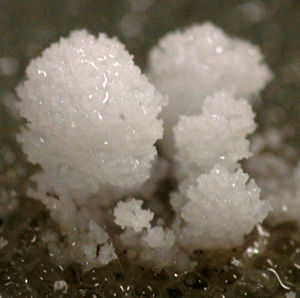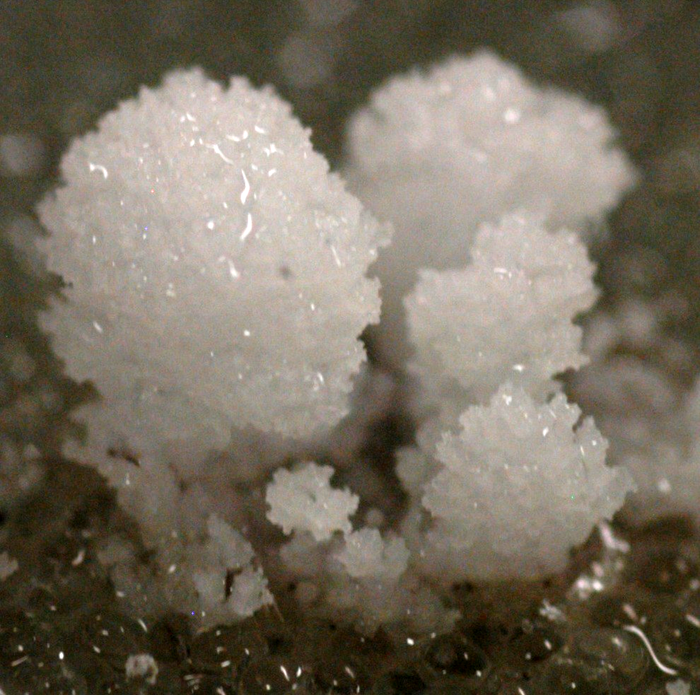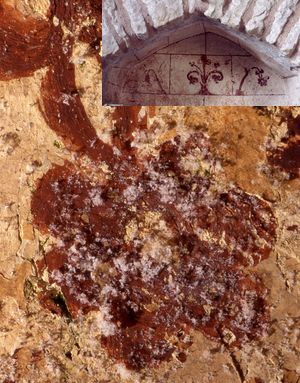Why Salt Clusters Form on Basement Walls
Salt deposits on walls and other structures can lead to serious damage, but researchers don’t fully understand how they form. Now a French team reporting in Physical Review Letters has performed experiments and computer simulations of salt crystallization on porous structures and explains why the crystals form in discrete bunches, rather than uniformly coating the surface. The new understanding may help in the conservation of old buildings and art pieces.
“Efflorescence” is the name given to the “flowering” of salt often seen on walls in damp basements and old churches, as well as on new concrete and brick structures. It’s a sign that the porous material has been infiltrated by water seeping up from the ground or condensing from the surrounding air. As the water evaporates, any salt dissolved in the fluid will crystallize. This deposit—which may be sodium chloride or another salt like gypsum—can sometimes lead to structural damage, especially if the crystals grow inside the structure, causing internal stress. The problem is especially acute for art conservators trying to restore frescoes and old paintings that have become hidden under a salty glaze.
To better understand efflorescence, Marc Prat and his colleagues at the University of Toulouse in France investigated the factors that control the spatial organization of the salt crystals. “The practical motivation is to develop models aimed at predicting salt damage,” Prat says. They first designed an experiment that mimics the general conditions of efflorescence. They created a porous material by packing millimeter-sized glass beads into a 2-centimeter-wide, 5-centimeters-long Teflon cylinder. The cylinder was suspended vertically, with the bottom portion submerged in a sodium chloride solution. By capillary action, liquid wicked up to the top through the spaces between the beads. As the water evaporated from the top surface, it left salt crystals behind.
As is commonly observed, the salt formed in discrete patches, rather than uniformly over the surface. But the team also noticed that the salt crystallized preferentially on the periphery, near the cylinder wall. To explain this, they performed numerical calculations and found that the evaporation rate is higher near the cylinder wall than at the center. The evaporation rate, in turn, depends on the degree to which the surface is exposed to the circulating air above. The team varied this exposure by adjusting the height of the top surface relative to the top of the cylinder rim. These experiments convinced the researchers that higher evaporation in a certain region causes the fluid to flow up more rapidly from below, which leads to more crystals.
The team ran detailed computer simulations of the experiment, where they included the connection between evaporation and fluid flow. Representing the porous material as a network of randomly-sized pores connected by tubes of varying size, the team found that certain “high-speed” pathways allowed more rapid fluid flow and thus developed crystals more rapidly at their exit points on the surface. But instead of blocking evaporation at the pore, these crystals would boost the rate of evaporation by providing more surface area from which the fluid could evaporate. The increased evaporation would draw up fluid even faster along these high-speed pathways. In response, the flow through neighboring pathways would slow, and the corresponding pores would be “starved” of salt ions. The team says this process explains why salt crystals often form in isolation rather than in a uniform coat.
The team is developing the model into a quantitative theory that can predict where and how fast efflorescence will develop in a given situation. Such a theory could help in protecting artworks, Prat says. For instance, one could expose a valuable fresco to humid air to suppress evaporation, while pumping drier air on adjacent regions to induce efflorescence there, away from the artwork.
The paper “is based on a simple, but clever, analysis that accounts for the experimental observations quite well,” says George Scherer of Princeton University. “Without this theory, one might assume that the distribution of efflorescence represents scattered sources of salt, whereas this paper demonstrates that a uniform concentration of salty solution will still give patchy efflorescence.” He believes this insight, plus the demonstration of the importance of air flow, can help conservators judge how best to deal with efflorescence.
–Michael Schirber
Michael Schirber is a Corresponding Editor for Physics Magazine based in Lyon, France.
More Information
Focus: The Menace of Underground Ice
Viewpoint: Rush Hour in a Drop of Coffee
G. W. Scherer, R. Flatt, and G. Wheeler, “Materials Science Research for the Conservation of Sculpture and Monuments,” MRS Bulletin 26, 44 (2001)







